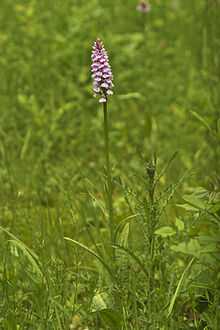Dactylorhiza maculata
| Heath spotted orchid | |
|---|---|
 | |
| Dactylorhiza maculata subsp. maculata | |
| Scientific classification | |
| Kingdom: | Plantae |
| (unranked): | Angiosperms |
| (unranked): | Monocots |
| Order: | Asparagales |
| Family: | Orchidaceae |
| Subfamily: | Orchidoideae |
| Genus: | Dactylorhiza |
| Species: | D. maculata |
| Binomial name | |
| Dactylorhiza maculata (L.) Soó | |
| Synonyms[1] | |
| |
Dactylorhiza maculata, known as the heath spotted-orchid[2] or moorland spotted orchid, is an herbaceous perennial plant belonging to the family Orchidaceae. It is widespread in mountainous regions across much of Europe from Portugal and Iceland east to Russia. It is also found in Algeria, Morocco, and western Siberia.[1][3]
Etymology
The name of the genus Dactylorhiza is formed from Greek words δάκτυλος "daktylos" meaning "finger" and ρίζα "rhiza" meaning "root" and refers to the tubers of this plant, that are split into several tubercles. The specific Latin name "maculata" (=spotted) refers to the stained leaves. The scientific binomial name of this plant was initially Orchis maculata, proposed by the Swedish naturalist and botanist Carl von Linné (1707–1778) in 1753. The name has been subsequently amended to the one currently accepted (Dactylorhiza maculata), by the Hungarian botanist Károly Rezső Soó (1903–1980) in 1962. In German this plant is called Geflecktes Knabenkraut, in French is called Orchis tacheté, in Italy is called Orchide macchiata.
Description
Dactylorhiza maculata reaches on average 15–45 centimetres (5.9–17.7 in) of height, with a maximum of 70 centimetres (28 in). These plants are bulbous geophytes, forming their buds in underground tubers or bulbs, organs that annually produce new stems, leaves and flowers. Furthermore these orchids are "terrestrial", because unlike "epiphyte" species they do not live at the expense of other large plants.
This orchid has an erect, glabrous and cylindrical stem, with a streaked surface. The leaves are oblong or oval-lanceolate, with dark ellipsoid-shaped "spots" on the surface (hence the species name). The leaves are amplexicaul and can be either radical (basal) or cauline.
The underground part of the stem has two webbed tubers each one more or less deeply divided into several lobes or tubercles (characteristic of the genus Dactylorhiza), the first one plays the important functions of supplying the stem, while the second one collects nutrient materials for the development of the plant that will form in the coming year.
The inflorescence is 5–15 centimetres (2.0–5.9 in) long and it is composed of flowers gathered in dense spikes. The flowers are placed in the axils of bracts membranous and lanceolate-shaped. Their colors vary from light pink to purple or white with darker streaks mainly on the labellum (sometimes at the margins of tepals). The flowers reaches on average 10–15 centimetres (3.9–5.9 in). The flowers are hermaphrodite and pollinated by insects, especially bumblebees. However the seeds germination is conditioned by the presence of specific fungi.
Habitat
The Heath Spotted Orchid prefers sunny places on lowlands or hills, it can be found in slightly damp meadows, but also in the undergrowth of dry forests, in areas with bushes and at the edges of streams. They grow on siliceous and calcareous substrate, at an altitude up to 2,200 metres (7,200 ft) above sea level.
Subspecies
Many names have been proposed for species and varieties in the species. As of June 2014, the following are accepted:[1]
- Dactylorhiza maculata subsp. maculata (L.) Soó - most of species range
- Dactylorhiza maculata subsp. battandieri (Raynaud) H.Baumann & Künkele (1988) - Algeria
- Dactylorhiza maculata subsp. caramulensis Verm. (1970) - France, Spain, Portugal
- Dactylorhiza maculata subsp. elodes (Griseb.) Soó (1962) - much of Europe from Portugal and Iceland east to European Russia
- Dactylorhiza maculata subsp. ericetorum (E.F.Linton) P.F.Hunt & Summerh. (1965) - British Isles, Sweden, Germany, France, Netherlands, Belgium, Spain
- Dactylorhiza maculata subsp. islandica (Á.Löve & D.Löve) Soó (1962) - Iceland
- Dactylorhiza maculata subsp. podesta (Landwehr) Kreutz in C.A.J.Kreutz & H.Dekker (2000) - Netherlands
- Dactylorhiza maculata subsp. savogiensis (D.Tyteca & Gathoye) Kreutz (2004) - France, Spain, Italy
- Dactylorhiza maculata subsp. schurii (Klinge) Soó (1967) - Romania, Ukraine
- Dactylorhiza maculata subsp. transsilvanica (Schur) Soó (1962) - Hungary, Bulgaria, Romania, Yugoslavia, Ukraine, Czech Republic
Gallery
-
Flowers
-
Close-up on inflorescence
-

Inflorescence
-

Inflorescence
-

Fruits
-

The tubers are split into several tubercles, hence the name Dactylorhiza
-
The stained leaf, hence the name "maculata" meaning =spotted
References
- ↑ 1.0 1.1 1.2 Kew World Checklist of Selected Plant Families
- ↑ "BSBI List 2007" (xls). Botanical Society of Britain and Ireland. Archived from the original on 2015-02-25. Retrieved 2014-10-17.
- ↑ Altervista Flora Italiana, Orchide macchiata, Dactylorhiza maculata (L.) Soó includes European distribution map
- Pignatti S. - Flora d'Italia (3 voll.) - Edagricole - 1982
- Tutin, T.G. et al. - Flora Europaea, second edition - 1993
External links
-
 Media related to Dactylorhiza maculata at Wikimedia Commons
Media related to Dactylorhiza maculata at Wikimedia Commons -
 Data related to Dactylorhiza maculata at Wikispecies
Data related to Dactylorhiza maculata at Wikispecies - Den virtuella floran - Distribution
- Biolib
- Dactylorhiza maculata
- Manfred Hennecke


